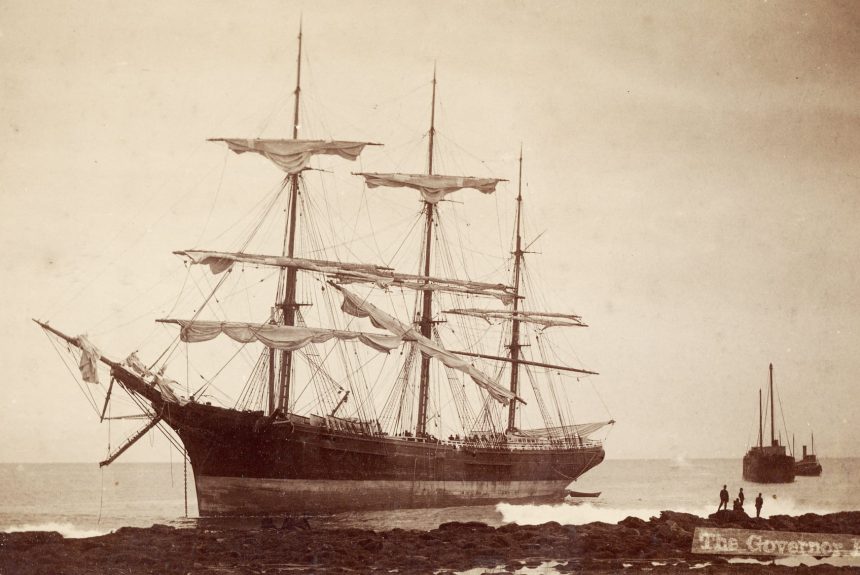Ship Gov Robie Driven on the Rocks at Timber Island
The ship Gov Robie was under full sail and making four knots when she struck the rocks at Timber Island in the wee hours of March 5, 1889. Third Mate Phillips admitted that in the thick haze they thought they were near Richmond Island not Goose Rocks Beach. The crew on the 228-foot ship was also short-handed. On the last leg of their journey, four of the 16 men before the mast had become sick with what they feared was a contagious illness.
Lifeboats arrived from Biddeford Pool just as Mr. William Sinnett of Cape Porpoise was attempting to get his fishing dory close enough to the ship to load the captain’s family off. The sick crewmen were taken to the Biddeford Pool life-saving station. Captain Blanchard and his family made their way to the Curtis House on Timber Point.
On this round-trip voyage from Portland to New York to Japan and back, Captain William H. Blanchard of Searsport, his wife Clara and their daughter Eleanora had been aboard the Gov. Robie for about a year. Their elegantly furnished cabin had all the conveniences and furnishings of a luxurious home including a fully stocked library and a piano. Clara Pendleton Blanchard, a daughter, a wife and a mother of sea captains lived mostly at sea for more than 40 years. She gave birth to three of her six children at sea. Captain Blanchard often bragged about his midwifery.
The morning after the Timber Point wreck, chances of getting the Gov Robie off the rocks before she went to pieces seemed slim. She had shifted considerably overnight. There were four feet of water in her hold and part of her keel had washed ashore. The outline of the vessel could be seen from Cape Porpoise. Crowds of people flocked to Goose Rocks Beach to see the stranded ship up close. Several tried to board her to scavenge her valuable cargo of Japanese curios for a New York concern; one pair of vases alone were worth $1,000.
The following day, the marine underwriting firm of Leavitt Chase & Co began loading the fully insured cargo of bamboo seeds and rags for Maine’s Cumberland Paper Mill onto lighters and employed watchmen to protect the ship from looters. Three hundred bales of rags were temporarily stored on the docks at Biddeford Pool. People living nearby worried that those wet rags carried the contagious disease that had afflicted the crew. Mayor Goodwin consulted the city physician and based on his assurances allowed the rags to remain. At each high tide attempt were made to float the Gov Robie off but even with four tugboats on the job they couldn’t budge her. Between tides the underwriters worked continuously to lighten the load. 1700 cases of curios and 1000 tubs of camphor wax were loaded onto a barge headed for New York.
Finally, at 8 o’clock on the morning of March 15th, ten days after she ran aground the massive ship slipped off her bed of rocks stern first and was towed to Portland for repairs.
Captain Blanchard retired from her command but would continue to sail for the rest of his life. He died at sea in September 1904 when the bark Willard Mudgett, commanded by his son Captain Frederick Pendleton Blanchard, sank leaving no survivors.
The Gov Robie, built in 1883 in Bath, Me., outsailed Captain Banchard. She ended her days as an old coal barge some 20 years after the Timber Island incident.









Leave a Reply